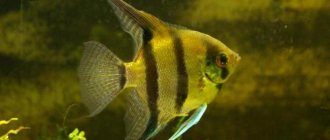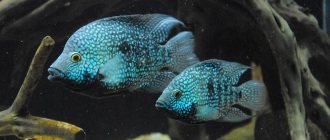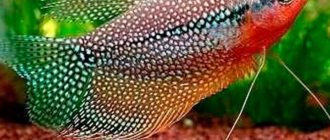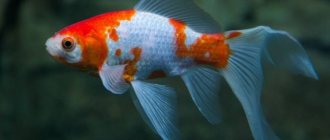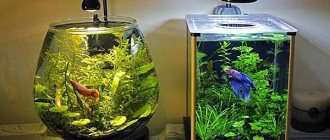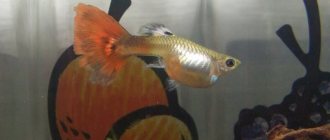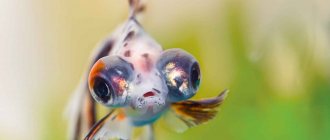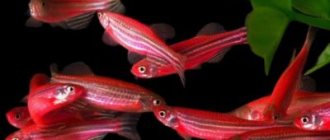Cichlazoma severum is a bright fish of the cichlid family. Its colorful appearance will decorate the most modest aquarium. The pet is easy to keep, so it is suitable for both beginners and experts in the aquarium business.
Scientific name of the fish: formerly Cichlasoma severum, now Heros severus.
In Russia they call it: false discus, cichlazoma severum.
Order, family: perciformes (Perciformes), cichlids (Cichlidae).
Favorable water temperature: 20-28°C.
"Acidity" Ph: 6.8-8.0.
Hardness dH: 6-20°.
Aggressiveness: there is aggression within the species, they eat small fish.
Content difficulty: easy.
Green Guyana
History of the species and description
The scientific name of Cichlazoma severum is Heros severus in Latin. It literally translates as “northern hero.”
The species was first described in 1840. It was found in the basins of large rivers in South America (Rio Negro, Orinoco). In nature, cichlazoma feeds on insects and fry. From plant food, fish sometimes eat algae.
Fish are smarter than many aquarium pets. Cichlazoma severum tends to recognize only one host. She is capable of hitting or biting another person who dares to disturb her. For her thoughtful look and peaceful disposition, she is called a philosopher among aquarium inhabitants.
Appearance:
- the body is laterally flattened, tall, length is about 20 cm; in nature it reaches 30 cm;
- the head is large, with thin lips, large round eyes, albinos have a red iris;
- The color depends on the variety, but there are many inclusions of golden color.
Severums are similar to distant relatives of discus fish. The length of their body directly depends on the space of the water reservoir in which they live.
Feeding
Cichlazoma severum is an omnivorous fish. Therefore, any food for aquarium animals will suit her. As the basis of the diet, you can give preference to special sinking tablets that are intended for cichlids. You should also give live food - worms, bloodworms, shrimp, tubifex, etc. Feeds of plant origin should play a special role in nutrition. In the wild, cichlazoma severum feeds on them. This could be some aquarium plants or pieces of green vegetables.
It is not recommended to feed fish with meat products: their gastrointestinal tract is not able to digest such food. This will lead to various diseases or obesity.
Compatibility with other fish
It is optimal when Cichlazoma severum lives in a spacious aquarium with relatives. The flock should consist of 6-10 individuals. "Northern heroes" do not show aggression, except during the spawning period, but they can eat small fish that will fit in their mouth. It is better to settle cichlids with representatives of medium-sized cichlids, which are distinguished by the same peaceful character. But slow small fish, as well as veiled ones, will not get along with them even if there is a lot of space and shelter. Severum is incompatible with neons, goldfish, tetras, and poeciliids.
Suitable neighbors:
- mesonouts;
- astronotuses;
- catfish;
- barbs, but not small ones.
We recommend reading
About swordtail fish
The aquarium philosopher has intraspecific aggression. Initially, you need to populate the aquarium with a school of young fish of the same age, or an established pair. This will avoid constant conflicts.
Determining the sex of severum
ARTICLES May 24, 2010 Quite a lot has already been written and said about this fish about severums, or as they are sometimes called heroes (lat. Heros), maybe this is due to their heroic behavior in nature: running away from a predator, they are integrated into a school of discus, and as a result, the discus is eaten , and the severum floats away safely; or maybe their name was influenced by their heroic defense of the nest, when the pair is friendly, the movements are synchronous, the fins are fluffed, the full mating-fighting outfit drives away the neighboring pair of severums or other cichlids...
..., or when two males stand with their mouths locked ... ..., two females ...
..., female-male ...
... or representatives of different species - find out whose trump card is older.
However, even experienced breeders continue to have questions about determining the sex of severums. In this article we will try to summarize many years of experience of accumulated information and our own observations.
Currently, many types of severums are appearing, the most common of them are: green severum Heros seerus green, gold severum Heros gold, red dotted severum Heros gold red spotted, red pearl Heros gold red spotted Super Red - selection aquarium morphs, or natural species Guyana severum Heros notatus gyana, red-shouldered severum Heros efasciatus, rotkail, red sholders, santarem (at one time we gave it the name “blue emerald” for the intense blue color of females) Heros notatus santarem, red spot santarem, new species - eight-striped severum Heros inirida, gestating severum in the mouth of Heros severus mouthbreeder. The Latin names of natural varieties often add the name of the place of catch or tributary of the Amazon (santarem, inirida, gayana) since the taxonomy of severums is still not completely clear (for example, in the latest catalogs Heros santarem appears as efasciatus).
There are several general criteria for determining sex, some of which have already been discussed previously by other authors. The most obvious sign is the absence of the so-called “speck” on the gill covers of females. Although we are talking about gill covers, the absence of “speckles” (spots from red to chocolate-black color) should be understood as - on the entire face of the fish, females will have an even, matte (or slightly velvety) shade characteristic of the species. Specks should also be considered small sparse dots along the very edge of the gill covers.
This applies to most natural species and to the aquarium form of “green severum” (Heros severus green).
In the presented photos of pairs of severums, the dotted pattern on the muzzle of the male and its absence on the female are clearly visible.The exception is the breeding form golden severum (Gold and the popularly beloved “red pearl”; in both of them, both females and males may have more or less pronounced specks on the muzzle.
However, this sign is confidently established when the fish has already grown out of adolescence and has changed the so-called “childish color” (clear stripes on the side and speckles on the muzzles and throughout the body), and it is interesting that, as a rule, females have an initial variegation of teenage color with age starts to disappear. This age varies in different species: in the well-known aquarium form of the green severum earlier (from 6-7 cm), in the rotkeil and santarem (from 9-10 cm), in the Gayan and eight-striped severum a little later, in the severum that bears this sign in its mouth appears in adulthood, with age, and is thought to accumulate with the number of spawnings.
For some species, you can use the method of determination in stress coloring; females will be lighter when examining the gayan in a net (taking it out of the water), in females the juvenile markings sharply turn pale (become light brown) and the body color is more olive-gold, while in males, the brightness of the markings does not change (black-brown), and the body color is dark green. When observing Guyanese severums in a bank for a long time, the females are quite easy to notice, but as soon as the net is lowered into the water, the entire herd is immediately distributed evenly among the cracks and becomes dark striped.
The same can be done with santarem (Heros notatus santarem), i.e. distinguished during stress. When you catch teenagers, they all look the same, as soon as they sit for a couple of minutes in a separate container (a jig or bucket), they will be distributed according to the intensity of the stress coloring, the males will be darker in color, the females will be lighter, provided that there is a group of fish and can be compared.
Questions often arise about what to do with golds and red dots (red pearls); for them, the “speckled” sign does not work. We have learned to identify by the shape of the head; males have a more pronounced frontal part (sloping forehead); females have a sharper muzzle.
The signs are quite subtle and relative, so observing the behavior of fish comes to the rescue. In fry and juvenile redspots, according to our observations, in males the throat area where the gill covers connect is somewhat more massive, the body and back are brighter, more reddish - noticeable when caught (in a net in a bucket), in females the body is paler and the muzzle is sharper, but in young animals there are errors more likely.
Another characteristic is common among akarium fish: the length of the braids, or the length and shape of the dorsal fin. The method of determination is quite stupid, because braids grow in fairly mature fish and by this time, as a rule, it becomes clear who is who. Female golds and red dots have longer braids than males,
and in adult fish of natural species, their length may not differ. In addition, in banks with respectable neighbors, the braids may simply become frayed.
Knowledgeable breeders at one time determined the sex of adult savages by the distance between the anus and genital opening; mistakes occurred, since the size of the fish in this case can play a role.
Thus, there are enough criteria for determining the sex of severums and any aquarist can, if desired, determine the sex independently using those described above, both individually and in combination, which significantly increases the accuracy of the determination. Good luck!
Especially for AQA.ru, Maria (Experienced Wanderer).
- Discussion on the forum
All photographs in the article are copyrighted.
No entries found.
Varieties of aquarium fish
The work of breeders has practically displaced the severum that exists in the natural environment from aquariums. Different species have been bred for home keeping.
Severum red-headed (also known as red-shouldered) is distinguished by reddish-orange fins and a stripe on the head of the same color. Also called rocktail. Grows up to 25 cm.
Severum green Guyana - fish up to 20 cm in size, green in color with yellowish tint, oblong speckles on the body.
Severum red dotted – the main color is bright yellow. Reddish spots are scattered all over the body. Size no more than 15 cm.
Amazonian severum - the main tone ranges from yellow-gray to brownish, the body length is 15-17 cm. Based on this particular species, breeders have created most of the other varieties.
Severum Santarem are gray fish with a bluish or purple tint.
Severum turquoise Peruvian - has a striped color. Adults are distinguished by orange and turquoise fins. Size 15-18 cm.
Kinds
To date, such a number of severums of various colors and sizes have been bred through selection that some of them are not even divided into separate species. Selection forms are crossed with each other, obtaining more and more new subspecies. The most popular varieties are: red pearl severum, blue emerald (santarem), gold, red shoulder (rottail), green Guyana severum.
Red pearl
Severum red pearl (red-spotted) is a peaceful, golden-colored fish with many red spots. The color of the scales can vary from pale yellow to rich red (due to the large number of scarlet spots). Cichlazomas severum red pearl are not shy and love to study the world around them, leisurely contemplating everything around them. However, during spawning, the behavior of Cichlazoma severum red pearl changes dramatically. The fish zealously defends its territory and enters into numerous skirmishes with its fellows.
Blue emerald
Blue emerald is colored blue or blue with an emerald tint. It is not difficult to distinguish males from females. Black stripes on the sides in infancy, turning into spots with age, indicate male sex.
Gold
Golden severum is a light yellow aquarium fish with a golden tint. It does not have any stripes or pronounced spots. In males, the golden color turns orange. This species also includes albinos with soft pink scales and reddish eyes.
Redshoulder
Redshoulder (rottail) is one of the most prominent representatives of the severums. It appeared in our country recently, but is already very fond of aquarists for its unusual color, unpretentiousness in maintenance and gentle disposition. The body of this fish is silvery or greenish in color, and behind the gills there is a spot of red, sometimes orange. Males have a brighter color, and dark spots are scattered across the body and forehead. Females have a uniform color. Like other cichlid species, it shows aggression during spawning.
Green
Green severum (Gayana) has yellowish or green scales. Males have black spots all over their bodies, with stripes of the same color running down their sides. Females have a uniform color. Unlike other fish of this species, the green severum prefers to live in the lower and middle layers of the water.
Return to content
The most popular representatives
Some types of Cichlazoma severum are considered the rarest, most expensive, fashionable, or simply enjoy special love.
Severum motbreeder is perhaps the most interesting representative of cichlids. The body is colored yellow. There is a dark stripe closer to the tail. The uniqueness of the fish is that it bears fry in its mouth. She is smaller than other severums. Interestingly, this species has maintained the purity of the line. He was not mixed with others.
Severum blue emerald (inirida) - many aquarists dream of getting it. The body is blue or light blue, sometimes with a green tint. Spots are visible on the sides, which in young fish look like stripes.
Severum “red pearl” looks very elegant in an aquarium. It is distinguished by a white or yellowish body with red spots. It is classified as an albino, but sometimes there are so many spots that it creates the illusion that the fish is completely red.
Golden severum are yellow-colored individuals; males have a bright “mask” of orange tone. They are often called "gold". The fish are partial albinos. The body is almost disc-shaped.
Other shapes and similar species
Over the years of captivity, “domestic” severums have changed significantly. In the wild, they looked much more modest: only the abdomen was bright yellow, the sides were gray-green, with a large number of red dots. There are also subspecies with different colors in nature.
- The Red-bellied Severum or Moatbreeder is primarily golden olive in color and has a bright red belly. It differs from its relatives in that it bears eggs directly in its mouth.
- The red-shouldered severum or rocktail is colored in shades of green, against which the wide orange “collar” behind the head and red fins look advantageous.
- The Blue Emerald makes effective use of the blue-green color scheme that blends across its scales. Bright yellow eyes and lower fins make its appearance exotic.
- The green Guyana severum is the most slender of the genus: its yellow-green body is elongated.
You can no longer find wild-colored fish in an aquarium. Geneticists have used the presence of a large number of different pigments in it to develop amazing, different breeds. The most popular were:
- golden severum with rich yellow scales and an orange mask in males;
- red pearls with many spots on yellow scales;
- albinos with light scales, on which a red pattern may appear.
In Russia, severums are also called false discus, noting the similarity of the fish.
Conditions for correct content
Novice aquarists love severums for their unpretentiousness and resistance to disease. The fish tolerate temperature changes well. The only constant condition for proper maintenance is a spacious tank.
We recommend reading
About aquarium knife fish
Optimal conditions for fish:
- tank 200-500 l;
- liquid temperature – 23-28ᵒC;
- hardness – 5-20 dH;
- acidity – 6-7 pH.
The best soil is small pebbles or coarse sand. Severums, as befits cichlids, burrow at the bottom and nibble on algae. Plants in an aquarium must have a good root system and hard leaves, otherwise they will be dug up and eaten. Vallisneria and cryptocorynes are suitable.
You can place driftwood and grottoes for beauty. Water is changed weekly by 30%. Be sure to install a filter and a powerful aerator. Lighting does not play a big role - severum feels normal at any intensity of day length and light intensity.
Maintenance and care
Severums are considered the hardiest cichlasomas. They stoically withstand short-term drops in temperature, forgive mistakes in determining acidity and live in water of any hardness without getting sick or losing their attractiveness.
The parameters that you need to focus on when keeping severums are given in the table below.
| Satisfactory | Optimal | |
| Temperature | 20-28 | 25 |
| Acidity | 6.8-8.0 | 7.0-7.6 |
| Rigidity | Doesn't matter | 6-20 |
| Aquarium volume | From 150 l per couple | From 250 l per couple |
Severums are true long-livers. In good conditions, they live up to 15 years, maintaining beauty, health and good appetite.
Arrangement of the aquarium
When thinking about purchasing severums, the first thing you need to consider is the availability of the required area.
While easily forgiving of other shortcomings in maintenance and care, these fish will not tolerate restrictions in space. Their rule is simple: the larger the aquarium, the better. The minimum that one pair can be kept in is 150 liters. For this species, this is an “economy” option: the conditions are tolerable, but not comfortable.
The shape of the aquarium is of great importance and affects the appearance of severums. When tall, the fish grow in width, gradually rounding out and becoming similar to discus fish. In narrow ones they stretch out in length.
The bottom of the aquarium is covered with a layer of gravel or small smooth stones. Large boulders and driftwood are generously placed on top of them, and caves and grottoes are made.
Plants for an aquarium with severums are chosen to be strong, with hard leaves, a strong root system and fast growing. For example, Vallisneria or Cryptocoryne.
Plantings must be strengthened by placing large stones around them. This is the only way they have a chance to hold out for any long period of time. These fish take great pleasure in “gardening,” either digging up greens, tearing off leaves, or simply crumbling them into pieces.
- A powerful filter and compressor are needed: severums prefer clean water. They will also appreciate the gentle current, which will help create technical means.
- These fish have no special requirements for lighting. Nine hours of daylight with medium-intensity lamps is quite enough for them. In this case, you should make sure that the aquarium has shaded areas where the fish can rest during the day.
An important element in aquarium design is the lid. Severums are excellent athletes, capable of jumping tens of centimeters. In an open aquarium, this ability can be fatal for them.
Feeding
Severums are omnivores and have an excellent appetite. They have a favorable attitude toward food of various types, eating all insects and small crustaceans offered, live and frozen.
As a treat, from time to time you can offer them meat shavings or balls of lean ground beef without seasonings or other impurities. Pets will also be delighted with deep-frozen pieces of fish fillet or seafood.
They also liked industrially produced dry food. Feel free to add granules and flakes to your diet, but don’t limit yourself to them! Food should be varied.
- For good digestion and prevention of vitamin deficiency, fish need plant food. You can use duckweed as a substitute, periodically adding small shoots of the plant to an aquarium with cichlids.
- They will enjoy severum and spinach or lettuce leaves. They are thoroughly washed, scalded with boiling water and cut into small pieces.
To enhance color and rapid growth, aquarists advise giving small pieces of pumpkin. Severums are fed daily, giving food 1-2 times. Fasting days are arranged every two weeks.
Regular care
Once a week, it is necessary to update the water in the aquarium, replacing up to 1/5 of the total volume. The soil and walls of the aquarium also need regular cleaning.
Feeding in an aquarium
Despite the fact that the fish is considered a predator, it is an omnivore. To satisfy its protein needs, give shrimp, bloodworms, and brine shrimp. Dry food from a pet store is also suitable as food.
Spinach and lettuce are good substitutes for plant foods. The greens should be fresh, scalded with boiling water, and chopped. Complementary feeding of green peas is allowed. At the same time, even with a normal diet, you should not be surprised if the fish eats the tender parts of the algae in the aquarium.
Cichlazomas in captivity must eat a variety of foods. Then their health will be good and their behavior will be active. Particular attention should be paid to a varied diet during spawning.
Feed 4-5 times a day in small portions. Choose one meal time so that there is a routine. To prevent obesity, which negatively affects health, fish are given a “fasting day” once a week. If all the food is not eaten during feeding, it is removed so that the water remains clean.
Keeping in an aquarium
More often than others, you can find Severum redspot in home aquariums; its maintenance is not particularly difficult. The same can be said about other varieties. The main requirement concerns the size of the aquarium, since this indicator greatly affects the quality of life of cichlases. It is better to select a container with a volume of 200 liters or more, because this fish is quite large and needs room to swim.
In addition, cichlids are territorial fish and it is necessary to provide shelter for them to minimize the possibility of skirmishes. If a flock of severums lives in an aquarium, you need to think about zoning in advance. During puberty, the fish will split into pairs and each will need its own space. Although severums are slow and good-natured in appearance, they are characterized by strong intraspecific aggression.
You can divide the aquarium into zones using tall driftwood, several large plants, decorations or stones. If each couple has their own quiet corner, there will be no reason for a fight. Plants with thin, delicate leaves and a weak root system are not suitable for such an aquarium. Cichlids love to pull vegetation out of the ground and tear it apart. This is why many aquarists abandon live plants in favor of artificial ones, which can be additionally secured in the ground with special pins.
Interestingly, the body shape of these fish is directly related to the configuration of the aquarium. When kept in a narrow and high container, severums grow flatter and taller. In a wide and low aquarium, the fish will look fatter.
It has been noticed that the body shape of severums depends on the height and width of the aquarium.
Small pebbles, granite chips or coarse sand can be used as soil. Since severums are active, like other cichlids, the top of the aquarium must be covered with a lid, otherwise the fish may jump out. Severums are undemanding when it comes to aquarium water parameters; they are quite satisfied with the following indicators:
- temperature - 24−26°C, possibly lower;
- hardness - 4−10°dh, it is acceptable to take ordinary tap water;
- acidity indicators - 6−6.5 pH.
Cichlazomas do not like too bright lighting, but prefer diffused light. They also like the imitation of flow, which can be done using a powerful filter. At the same time, filtration will make the water cleaner, because large fish release a lot of organic matter during their life processes. A weekly 1/5 water change helps to further purify the water. The soil in the aquarium needs to be siphoned as debris accumulates at the bottom.
Severums like dim light and current in the aquarium.
Sexual characteristics and reproduction
Severums can be identified by gender from 6 months. The male has a pointed dorsal fin. The color of adult fish is bright, with a clear pattern on the gill covers. As the female grows older, she also acquires a pointed fin, but her color remains faded and there are no clearly defined spots.
The fish form pairs on their own. They become mature at 1.5-2 years. Stimulation of spawning occurs by increasing the temperature of the water in the tank by 2-3ᵒC, acidity is slowly reduced to a value of 6.2.
We recommend reading
Care and maintenance of betta fish
Spawning is possible in a common tank or in a spawning tank if its volume is at least 150 liters. Before breeding begins, the couple performs a “dance” with their mouths locked. Then the female lays 300-1000 eggs on any flat surface: stone, glass, algae leaves. The male fertilizes the eggs.
Both parents protect the future offspring and the surrounding territory, therefore, if spawning occurs in a common “house”, severums show aggression, although they rarely engage in fights.
Fish breeding
If an aquarist decides to breed severums, it is better for him to initially purchase a flock of 6-8 pieces. Growing up, cichlids independently choose a partner for spawning and form a stable pair with him. Reproduction in cichlasomas, like other fish, occurs when favorable conditions occur. In order for the parameters in the aquarium to become suitable for spawning, frequent water changes, softening and increasing the temperature are necessary.
During the spawning season, severums can become aggressive
If there are other inhabitants in the aquatic system besides severums, it should be taken into account that future parents can become aggressive and start fights. At the time of spawning, the female chooses a smooth surface (most often a flat stone), where she lays her eggs. At the same time, the roar can sweep away up to 1000 eggs. After this, the male fertilizes the eggs. In the following days, the couple guards the clutch and takes care of it, selecting spoiled eggs and fanning the eggs with fins for better aeration.
After the tiny fry appear, the parents begin to secrete a special skin secretion, which serves as food for the larvae. Additionally, you can feed the offspring with rotifers and daphnia. At one and a half months, babies become full members of the pack. At this point, the size of each of them is slightly more than 1 cm. Starting from the age of three months, young animals begin to eat the same food as adults, only in a smaller fraction.
Development of the offspring of “northern heroes”
The incubation period extends for a week. All this time, both parents monitor the offspring. They throw out dead eggs and ventilate the laying site with their fins. Severum fry begin to swim on the seventh day after birth. Then they can be given starter food, such as microplankton, special fry food or Artemia nauplii. For another 2-3 weeks, the mother and father stay nearby, protecting the fry from any, even hypothetical, danger. If one of the foreign fish swims too close, the parents drive away the intruder or hide the kids in their mouths.
Juveniles grow slowly. Only after a month do their bodies reach 1 cm in length. At the same time, the babies begin to develop colors, and their parents no longer protect them. It is important that the water in the aquarium with the fry is always warm, otherwise the young fish will develop various physical abnormalities.
Description
The natural habitat of this animal is the Amazon River and its tributaries. The body of these fish is flattened on the sides and has a more rounded shape than an elongated one. In the wild, individuals reach a length of 20 cm, but in artificial conditions they grow no more than 15 cm, but even this is considered an excellent indicator, since usually fish in aquariums are much smaller in size than their wild counterparts.
Severum is distinguished by long fins. The anal and dorsal begin almost from the head and run along the entire body, right up to the tail. The curious thing is that these animals vary greatly in color, and it directly depends on the parents and whose gene ultimately predominates. If it is dominant, then the fish has more green tones on the body, if it is recessive, then it is yellow. There are also albino individuals in whose body the dominant gene is absent. An interesting external feature is the eyes of false discus fish. They have a large iris with a red tint.
With good care, a severum cichlid can live at home for approximately 15 years. She is able to reproduce for most of her life. It is quite easy to distinguish a female from a male. Males are larger and brighter, and their fins are more visible. In addition, during the spawning period you can see their anal tubercle.
Curious facts about pets
In Cichlazoma severum, both sexes are capable of secreting a skin secretion, which they feed the fry for the first time after their birth.
Sometimes two female severums form a pair and simulate spawning, while remaining sterile. This usually happens if there is no male. The male sex does not form pairs. In the absence of female friends, males divide the territory and protect each of their own areas.
The body of a severum changes depending on the shape of the vessel in which it lives. If the aquarium is high, the pets increase in width, and if it is low and narrow, they stretch in length.
Share your impressions of the article in the comments and like it if you liked it. Share useful information with your friends on social networks.
Interesting things about severums
— Producers (male and female) are able to secrete a special secretion from the epithelium on which the juveniles feed. Therefore, as a rule, there are no problems with raising severum juveniles. However, sometimes this may not happen due to the fish’s adaptation to aquarium life; parents are simply too lazy to feed their babies.
— Cichlazomas severum are capable of forming not only opposite-sex pairs, but also monogamous ones (two females). The eggs of such producers, accordingly, remain unfertilized.
Cichlazoma severum diseases
Cichlazoma severum is resistant to diseases, like most aquarium fish.
The deterioration of pets' condition is most often associated with poor living conditions and errors in caring for them.
Cichlazoma severum is sensitive to increased concentrations of nitrogen-containing substances in the aquatic environment. With such a deterioration in the quality of the aquatic environment, the behavior of the fish changes noticeably. In this case, cleaning measures should be carried out and part of the aquatic environment should be replaced.
On forums they often talk about ichthyophyriosis in Cichlazoma severum. The causative agent of the disease is the equiciliated ciliate Ichthyophthyrus. The fins of a sick fish become covered with whitish tubercles. When the first signs of the disease are detected, it is necessary to increase the water temperature in the aquarium to 30 degrees and increase aeration. If the symptoms of the disease persist and intensify (there are more and more tubercles), drug treatment is started.
According to the general rules, each new fish is quarantined for several days before being introduced into the general aquarium. This event will allow you to observe the “newbie” and treat him if necessary.
Behavior
Pisces are calm, unfussy - contemplators, intellectuals and philosophers. They recognize the owner and easily get used to the fact that he pets them and feeds them by hand.
A stranger who puts his hand into an aquarium may be severely hit or bitten.
Some fans of this species claim that the fish are able to communicate with each other using dull guttural sounds, reminiscent of tapping, which can be heard when being near the aquarium.
Considered less aggressive than most cichlids, aggression is directed primarily at individuals of their own species. Moreover, it can be shown not only by males to other males, but also by females to females.
They form stable pairs or triplets - one male and two females; they prefer to choose their own partners. An established family secures a certain territory, which it strives to expand over time, sometimes gradually occupying the entire aquarium and displacing all other fish.
Compatibility
Should be kept with fish of similar behavior and size. Small fish are perceived as food. Although American cichlids are less aggressive than African cichlids, it is still important to keep the aquarium spacious.
Then they will have their own territory to protect. Their own place and large neighbors significantly reduce the aggressiveness of cichlids.
They get along well with other small cichlids - black stripe, meek, bee. The same with catfish - veiled synodontis, plecostomus, sacbranchial.
Diseases
With proper care and a balanced diet, cichlazoma rarely gets sick.
Poor quality water and/or new fish can cause infection with ichthyophyriasis. The causative agent of the virus is an equiciliated ciliate. Main features:
- the appearance of whitish tubercles covering the body;
- loss of appetite;
- changes in behavior (pets become fearful, move less);
- scratching the abdomen on the ground.
The first aid for this disease is to gradually increase the water temperature. Then the water is replaced by removing liquid from the bottom and adding fresh water. If possible, sick individuals are placed in a separate container. There are also many special preparations that disinfect the environment and destroy parasites.
Poor living conditions cause the development of head erosion in severum. It is determined by the appearance of a pit on the pet’s head. The cause of the disease is a monotonous diet and lack of vitamins. Untimely water replacement can also cause erosion.
Quarantining new specimens will help reduce the risk of disease in aquarium inhabitants. Beginners should be allowed into the aquarium only after making sure there are no infections.
Reproduction of severums
Just like most cichlids, representatives of the described species lay eggs on smooth surfaces (stones, leaves, aquarium glass). In the process of preparing the substrate, producers actively move pitfalls, pots, and pluck out plants. Thus, the fish clear the area around the future clutch. The reproduction of severums is accompanied by an increase in aggressiveness; they actively drive away not only representatives of their own species, but also other fish from their territory. Occasionally, disagreements arise between the male and female, then they begin to measure their strength, locking their mouths. As a rule, the female lays up to a thousand yellowish egg-shaped eggs with a diameter of 1 mm. The male then fertilizes them. During the process of maturation of the clutch, producers pluck out unfertilized eggs and dip the remaining ones with fins.
Recently, there has been a decrease in the parental instinct in severums, which is primarily due to the large-scale use of incubators for maturation of eggs. This leads to the fact that parents are not allowed to care for their eggs, and if in the case of non-parental producers they could eat their eggs, thereby leaving no offspring, then incubators allow the fry to be raised, preserving signs of weak parental instinct. It can be recommended to leave the first fry to their parents, checking their instincts.
Severum larvae hatch on about 3 days, depending on the temperature. A week later, the fry “takes wing” and begins to look for food for a larger faction. At this stage, he needs daphnia, rotifers, brine shrimp, etc. At first, the fry develops extremely slowly and reaches a centimeter only in the first month. They are starting to look like "true" discus fish with their tall, flattened bodies. Thanks to the dark color and a number of vertical lines, the fry are well camouflaged against the background of vegetation. By about three months, severums are already able to consume tubifex, bloodworms, and chopped earthworms. But you shouldn’t pamper them with bark, since the latter does not have a sufficient composition of nutrients. The camouflage of the fry dissipates around the first year of existence. Sexually mature individuals, as a rule, lack vertical stripes and have only one line near the tail.
